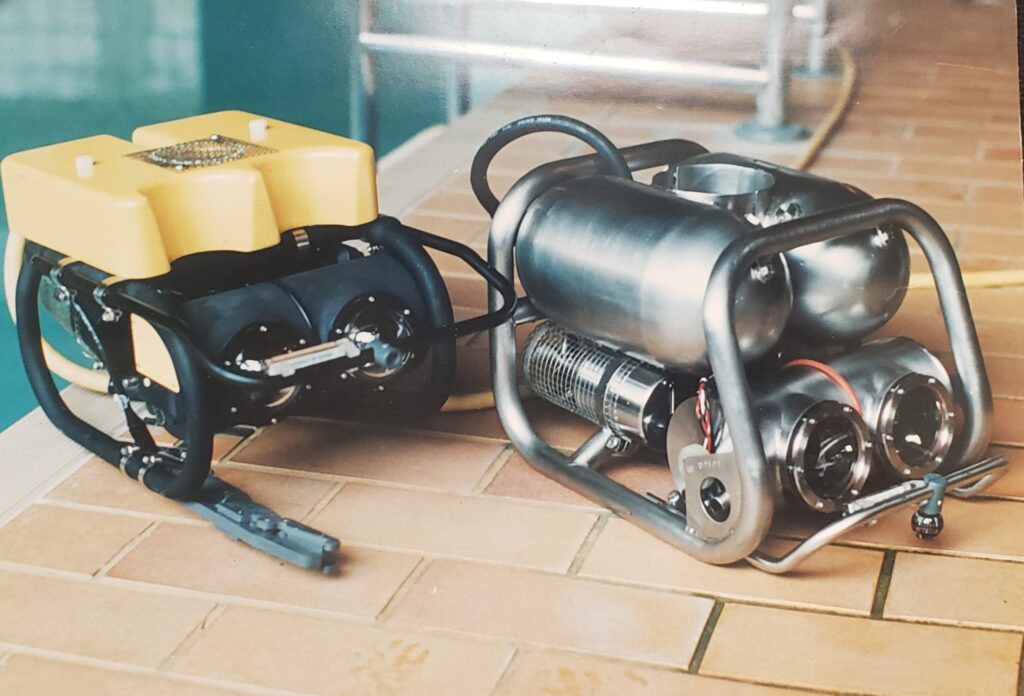Have you ever wondered how ROVs have evolved over the years? Or why they were invented in the first place? This blog post is intended to be a resource for all who are interested in understanding ROV history, how these robots have progressed, and how they are used today.
Remotely operated vehicles, or ROVs for short, are submersible robots that allow humans to explore water bodies without actually getting in the water. There are a wide variety of important tasks that take place below the surface and into the deep. I am sure you have noticed this before, but humans have not evolved the ability to breathe underwater. This unfortunate lack of skill has placed human lives in some tricky situations in the past. ROVs have been implemented in various industries to minimize the risk to humans. They more efficiently and effectively perform underwater tasks ranging from bridge maintenance, to search and rescue to discovering the deep sea. This was true in the 60s when ROVs first started to appear on the market, and it is even more true today.
ROVs have become an indispensable tool for many. In aquaculture, these special drones are used to maintain the nets and other submersed equipment of the farm. They help ensure the well-being of the animals and staff. For companies in the energy sector ROVs have become an essential tool for: pipeline inspections, maintenance and check-ups of underwater infrastructure, and the monitoring of active underwater equipment, all so that communities across the globe can be provided with the required electricity. These are just two examples. Perhaps, you are active in a different industry where ROVs are equally important.
However, the question spotlighted today is that of how ROVs came to be so important in the first place?
Humans have been building bridges for millennia. Aquaculture and the energy sector have definitely been around far longer than the 60s. So what’s up with that? Surely ROVs are just a fancy way of doing the same job that humans have been doing for a long, long time? Let us convince you otherwise.
ROV History
The beginnings of ROV technology are shrouded in mystery – it finds itself in murky water if you will. According to the Marine Technology Society there are two main players in ROV history. One of the fathers is Luppis-Whitehead Automobile, Austria, who developed the PUV in 1864. The Programmed underwater vehicle was a torpedo. It got the classification of vehicle or “locomotive” because it could propel itself through the water. Truly new was the lack of a driver or pilot. The first modern ROV was developed by Dimitri Rebikoff in 1953 and was given the name POODLE. As opposed to PUV, POODLE was a tethered ROV.
ROV technology really started to take off in the 1960s when the US Navy developed an interest for deep sea exploration. The first ROVs were dubbed “Cable-Controlled Underwater Recovery Vehicles” (or CURVs) because their main function was to lead search and rescue operations in deep and/or dangerous waters. The myth of once something has sunk it was lost to the sea had been busted. Think of the Titanic and other shipwrecks that have been explored thanks to the help of ROVs. Part of human maritime history has come back to life.
By the time the 80s rolled around, ROV technology had been adapted and was in use in the oil and gas industries. Today, adding another 40 years to the discovery, invention and innovation of ROV technology, they have infiltrated many more industries beyond military search and rescue.
ROVs Today
Part of what makes ROVs so attractive is their ability to do jobs that are simply too dangerous or physically impossible for humans to do on their own. Our bodies cannot dive 600m deep like the SEAMOR Chinook can. We are also not able to withstand strong currents without considerable risk to our safety. Our eyes are not adapted to seeing in murky water. We are not able to withstand the cold for long periods of time.
That being said, and contrary to a popular belief, ROVs are not here to replace humans. The robots require pilots to steer them and people still need to interpret all the information that the ROVs are collecting for us from the deep. On top of that, when the water is shallow enough, human dexterity is difficult to beat.
At SEAMOR we believe that ROVs are an essential player for future innovation and growth, especially for the listed industries below. If you find yourself in that list and you would like to learn more about what an ROV can do for your organization, get in touch here. We value your journey and your growth. We are here to help you achieve your goals.
Industries
- Aquaculture
- Hydro Dams
- Port Security
- Marine and Aquatic Research
- Nuclear
- Pipe Inspection
- Potable Water
- Search & Recovery
- Recreation
- Film & Documentary
Interested in learning more? Contact us below.

